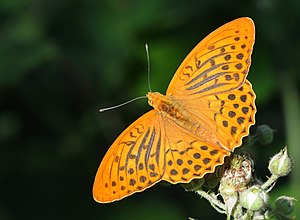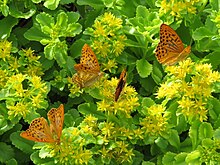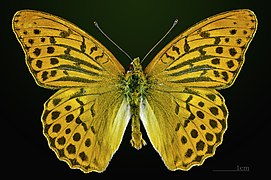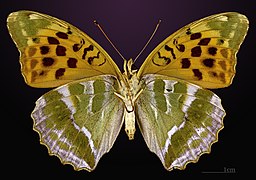Imperial coat
| Imperial coat | ||||||||||||
|---|---|---|---|---|---|---|---|---|---|---|---|---|

Imperial coat ( Argynnis paphia ) ♂ |
||||||||||||
| Systematics | ||||||||||||
|
||||||||||||
| Scientific name | ||||||||||||
| Argynnis paphia | ||||||||||||
| ( Linnaeus , 1758) |
The imperial coat or silver line ( Argynnis paphia ) is a butterfly ( butterfly ) of the genus Argynnis from the family of noble butterflies (Nymphalidae). It is the largest Central European mother-of-pearl butterfly . The specific epithet is derived from Paphia, an epithet of Aphrodite from Greek mythology .
features
Adults
The moths reach a wingspan of 55 to 65 millimeters in Central Europe. The upper sides of the wings of the males are bright orange and have brown spots, on the veins 1 - 4 there are dark scented stripes . The females are darker and a little greener, the scented scent strips are missing; the dark spots along the front edge of the forewings are stronger. The wing undersides of the forewings are pale orange, those of the hind wings are gray-green, covered with a narrow, slightly curved, silvery shimmering band from the front edge to the inner edge, which the butterfly owes its German name Silberstrich to.
Pre-imaginal stages
The yellow-gray eggs are conical and ribbed. The caterpillars are about 38 millimeters long. They are dark brown in color and have brown-orange thorns and two thin, closely spaced, yellow back lines. Behind their heads they also have a pair of black thorns that are drawn forward like antennae. The tumbling doll is gray-brown, with pointed horns and corners and has conical tips that are initially silver and golden before hatching.
Subspecies and forms
- Argynnis paphia f. valesina ( esper ). The dark form of the females has a dark upper surface, especially on the hind wing, which can sometimes have a blue sheen. It is rare in Central Europe, but it can be the dominant morph in the south (Spain and Italy) and east of the distribution area. B. in Ireland perfect.
- Argynnis paphia diva ( Oberthür ). Occurrence in Algeria . The well-developed drawing of the yellow underside of the hind wings often lacks the silver stripe, instead the region is sometimes banded without any trace of green, in other cases gray-green. The upper side of the wings of the males is fiery red. Both sexes have much more serrated hind wing margins than the typical shape.
- Argynnis paphia immaculata ( Bellier ). Occurrence in Corsica and Sardinia . The silver stripes on the undersides of the darker green-brown hind wings are reduced and the undersides have a gold shimmer.
- Argynnis paphia anargyria ( Staudinger ). In the extreme south of Europe, the underside of the hind wing loses its silver, so that the bandages only pass through the often dull, green-dusted hind wing surface in a cloudy ocher yellow. Occurrence in Spain , Italy , occasionally southern Greece .
- Argynnis paphia f. delila ( Huebner ). The males are redder and the females are darker. They occur in Asia Minor in the Taurus Mountains .
- Argynnis paphia f. tsushimana ( Fruhstorfer ) is named after its occurrence on the Japanese island of Tsushima . The shape is the most colorful of all known paphia shapes. The hind wing bandages are even darker green on the underside than in valesina , and the fore wing apex is also deep, dark, sea green. The silver bands of the hind wings appear unusually broadly white, sharply protruding, and the green submarginal spots are more isolated and not as blurred as in Chinese paphia forms.
- Argynnis paphia f. megalegoria ( Fruhstorfer ). The Chinese forms are always larger than the European ones, the females are the largest of all and even surpass the African forms. In them, the hind wing underside is more richly green pollinated than in European forms, but they are lighter than in the Japanese form.
- Argynnis paphia f. valesinides ( Fruhstorfer ). In northern China (e.g. near Beijing) this valesina- like form of the females flies . It is the more common, flies almost exclusively in some areas and looks very similar to the European valesina shape, but is half the size.
Similar species
- Fiery mother-of-pearl butterfly ( Argynnis adippe )
- Great mother-of-pearl butterfly ( Argynnis aglaja )
- Middle mother-of-pearl butterfly ( Argynnis niobe )
- Small mother-of-pearl butterfly ( Argynnis lathonia )
- Cardinal ( Argynnis pandora )
Occurrence

Argynnis paphia is widespread and common in Europe : northern Spain in the west, France , Italy including the islands, Ireland , southern Great Britain , Fennoscandinavia , Greece , European part of Turkey . The entire distribution area extends through temperate Asia (Russia, Iran, China) to Japan . The vertical distribution ranges up to 1,000 meters in Europe and up to 2,000 meters in North Africa . They live on sunny forest edges , forest clearings rich in flowers with bushy edges and on meadows enclosed by forest, especially in mountainous areas. The moths rarely leave the forest areas.
Way of life
The moths fly annually in Central Europe in one generation from June to August, in southern Europe from late May to September. They prefer to suckle blackberry blossoms, scabioses , thistle heads and the double-gold inflorescences of the forest angelica . In courtship , the male follows the female, circling her from the bottom to the front and from the top to the back, while the female flies straight ahead with even flutter. The male sends out an attractant from scented scales . When the female is ready to mate, she lands on a bush or overhanging tree branch and stretches her abdomen up. It also releases an attractant from the glandular sacs. The union takes place on flowers, leaves or on the ground, often so tight that the couple remains united and one individual carries the other around.
The eggs are laid on tree trunks, preferably pines and spruces , near which violets grow. The females begin their flight in search of a resting place in the treetops. Once someone has found a suitable tree, it can be dropped vertically onto a sunny spot on the ground and basked in the sun. Then it flies short distances close to the lower plants and lands on some. It drums violently on the leaf cover with its cleaning paws and then flies to the next spot. Higher vegetation is avoided. The female begins to flutter up the tree in leaps and bounds at a height of about 1 - 2 m, each time only performing a few flaps of her wings. It flies around the tree trunk in a spiral to deposit an egg at intervals of ½ - 2 m. To do this, it sits vertically on the trunk and bends the abdomen at a right angle in order to place the egg in a crack, under a lichen or bark scale, where it is not visible and largely protected from sun and rain. When it arrives at a height of around 4 m, it leaves this trunk to start again from below on another. However, there are also observations (e.g. from Brandenburg) that the eggs were not laid on tree trunks, but instead on violets.
development
The caterpillars hatch in late summer and hide on the trunk without eating in order to overwinter. They only become active again next March and crawl down to look for food plants and begin to eat. During the day they hide on the underside of leaves and only come out at night. They pupate on pines or twigs near the ground.
Food of the caterpillars
The caterpillars feed on the leaves of various types of violets such as fragrant violets ( Viola odorata ), forest violets ( Violareichenbachiana ), rough violets ( Viola hirta ); allegedly the caterpillars were occasionally found on real meadowsweet ( Filipendula ulmaria ).
swell
Individual evidence
- ^ Arnold Spuler: The butterflies of Europe . tape 1 . E. Schweitzerbartsche Verlagbuchhandlung, Stuttgart 1908, p. 30 .
- ↑ a b c d e The Palaearctic butterflies . In: Adalbert Seitz (ed.): The large butterflies of the earth . tape 1 . Alfred Kernen, Stuttgart 1909, p. 241-242 .
- ↑ a b Heiko Bellmann : The new Kosmos butterfly guide. Butterflies, caterpillars and forage plants. Franckh-Kosmos, Stuttgart 2003, ISBN 3-440-09330-1 , p. 160.
- ↑ a b c d e Tagfalter I (Ritterfalter (Papilionidae), Weißlinge (Pieridae), Edelfalter (Nymphalidae)) . In: Günter Ebert, Erwin Rennwald (eds.): The butterflies of Baden-Württemberg . tape 1 . Ulmer Verlag, Stuttgart 1993, ISBN 3-8001-3451-9 , p. 413-421 .
literature
- Tom Tolman, Richard Lewington: The butterflies of Europe and Northwest Africa. Franckh-Kosmos Verlag, Stuttgart 1998, ISBN 3-440-07573-7 .
- Hans-Josef Weidemann: Butterflies: observe, determine. Naturbuch-Verlag Augsburg 1995, ISBN 3-89440-115-X .
Web links
- Lepiforum e. V. Taxonomy and Photos
- www.schmetterling-raupe.de
- www.eurobutterflies.com (English)
- Moths and Butterflies of Europe and North Africa (English)
- Argynnis (Argynnis) paphia at Fauna Europaea
- Video: Visual scheme "female" with the imperial coat (dummy experiment) . Institute for Scientific Film (IWF) 1956, made available by the Technical Information Library (TIB), doi : 10.3203 / IWF / W-705 .
- Video







